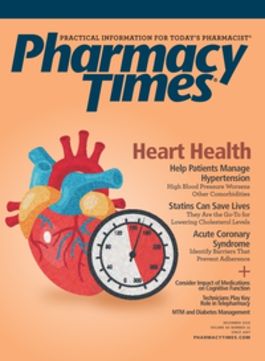Publication
Article
Pharmacy Times
Inqovi From Astex Pharmaceuticals, Otsuka Pharmaceutical, and Taiho Oncology
Author(s):
Inqovi (decitabine and cedazuridine) tablets from Astex Pharmaceuticals, Otsuka Pharmaceutical, and Taiho Oncology are indicated to treat adults with myelodysplastic syndromes.
The FDA has approved inqovi (decitabine and cedazuridine) tablets from Astex Pharmaceuticals, Otsuka Pharmaceutical, and Taiho Oncology to treat adults with myelodysplastic syndromes (MDS), including previously treated and untreated de novo and secondary MDS with the American-British- French subtypes of refractory anemia, refractory anemia with ringed sideroblasts, refractory anemia with excess blasts, and chronic myelomonocytic leukemia (CMML), as well as intermediate-1, intermediate- 2, and high-risk International Prognostic Scoring System groups.1
MDS are a heterogeneous group of hematopoietic stem cell disorders that may evolve into acute myeloid leukemia (AML). CMML is a clonal hematopoietic malignancy in which abnormal monocytes accumulate in the blood and bone marrow. CMML transforms into AML in about 15% to 30% of patients. Inqovi is the first oral hypomethylating agent.2
PHARMACOLOGY AND PHARMACOKINETICS
Decitabine is a nucleoside metabolic inhibitor. It causes hypomethylation of DNA and cellular differentiation and/or apoptosis, which may restore normal function to genes that are critical in the control of cellular differentiation and proliferation. Cedazuridine is a cytidine deaminase (CDA) inhibitor. CDA catalyzes the degradation of decitabine. High levels of CDA in the gastrointestinal tract and liver limit the oral bioavailability of decitabine. Coadministration of cedazuridine with decitabine increases systemic exposure of decitabine.
Both agents reach steady-state plasma concentrations 2 days after oral administration. Decitabine displays an elimination half-life of 1.5 hours. The half-life of cedazuridine is 6.7 hours.1
DOSAGE AND ADMINISTRATION
The dose of Inqovi is 1 tablet orally once daily on days 1 through 5 of each 28-day cycle. Each tablet contains 100-mg cedazuridine and 35-mg decitabine. It should be taken on an empty stomach.1
CLINICAL TRIALS
Inqovi was evaluated in open-label, randomized, 2-cycle, 2-sequence crossover studies. Patients were randomized 1:1 to receive Inqovi orally in cycle 1 and decitabine 20 mg/m2 intravenously in cycle 2 or the opposite sequence. Both groups received treatment once daily on days 1 through 5 of the 28-day cycle. Beginning with the third cycle, all patients received Inqovi orally once daily on days 1 through 5 of each 28-day cycle until their disease progressed or unacceptable toxicity occurred. The comparison of the 5-day cumulative decitabine area under the curve between Inqovi and intravenous decitabine found that the systemic exposure of Inqovi was comparable to that of intravenous decitabine.1,2
CONTRAINDICATIONS, WARNINGS, AND PRECAUTIONS
There are no contraindications to treatment with Inqovi. Fatal and serious myelosuppression and infectious complications can occur during treatment with Inqovi.
Fatal and serious myelosuppression and infectious complications can occur during treatment with Inqovi. A complete blood cell count (CBC) should be obtained before beginning treatment and before each cycle, with additional CBCs as clinically appropriate to monitor response and toxicity. A delay in treatment or dose reduction may be warranted based on the CBC results. Because Inqovi can cause fetal harm, all patients of reproductive potential should use an effective contraceptive during treatment. After the final dose of Inqovi, women should continue contraceptive use for 6 months and men for 3 months. Inqovi should not be used during breastfeeding. Animal findings suggest that Inqovi may impair male fertility. Medications that are metabolized by cytidine deaminase should not be used concomitantly with Inqovi.
The most common adverse reactions are arthralgia, constipation, cough, decreased appetite, diarrhea, dizziness, dyspnea, edema, fatigue, febrile neutropenia, headache, hemorrhage, increased transaminase, myalgia, mucositis, nausea, pneumonia, rash, and upper respiratory tract infection. The most common grade 3 or 4 laboratory abnormalities are a decrease in hemoglobin, leukocytes, neutrophil count, and platelet count.1
Monica Holmberg, PharmD, BCPS, earned her pharmacy degree at the University of Connecticut in Storrs and completed an ambulatory care residency at the Phoenix VA Health Care System in Arizona. Her practice has also included pediatrics and inpatient mental health. She lives in Phoenix.
REFERENCES
- Inqovi. Prescribing information. Taiho Oncology Inc; 2020. Accessed November 9, 2020.https://www.accessdata.fda.gov/drugsatfda_docs/label/2020/212576s000lbl.pdf
- Astex Pharmaceuticals, Taiho Oncology, and Otsuka Pharmaceutical announce FDA and Health Canada approval of Inqovi (decitabine and cedazuridine) tablets [news release]. Pleasanton, CA; Princeton, NJ; and Tokyo, Japan; July 7, 2020: Astex Pharmaceuticals Inc; Taiho Oncology Inc; and Otsuka Pharmaceutical Co Ltd. Accessed August 20, 2020. https://astx.com/astex-pharmaceuticals-taiho-oncology-and-otsuka-pharmaceutical-announce-fda-and-health-canada-approval-of-inqovi-decitabine-and-cedazuridine-tablets-oral-hypomethylating-agent-hma-therapy/







